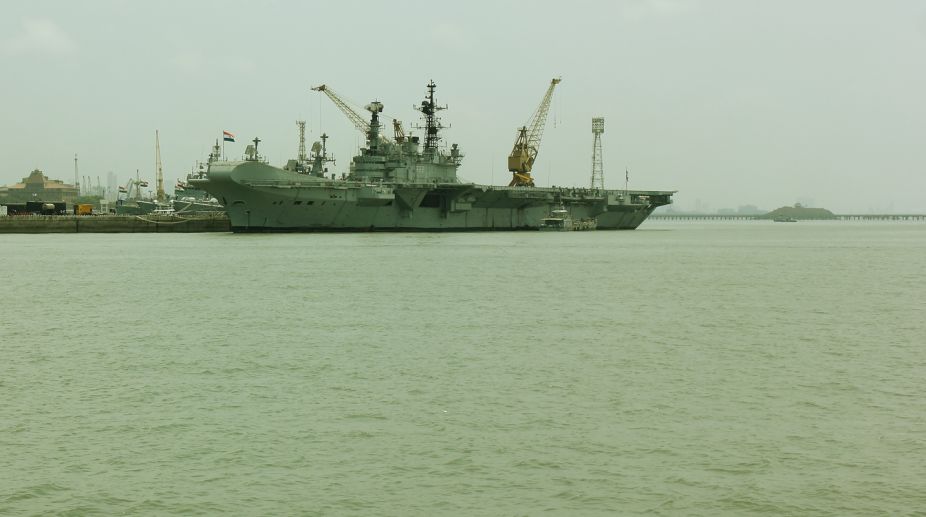Seawater, like the rest of the environment, is teeming with bacteria and other miniature life forms. Stationary structures like buoys, off-shore platforms or aquaculture nets get quickly covered by colonies of barnacles, bacteria and algae. The hulls of ships are known to get overgrown with organisms within a few months of an overhaul. The higher drag that ships experience has been reported to increase fuel costs by 28 per cent.
Most things we handle like packaging material, door handles, keyboards, pipes that bring us water, also get covered with bacteria, which lead to the spread of infection. It is the same in medical practice and patients in treatment run serious risks of contracting bacteria from devices like cathe-ters or tubes that deliver blood, saline or drugs.

The scale of the problem led Karoline Herget, Patrick Hubach, Stefan Pusch, Peter Deglmann, Hermann Götz, Tatiana E Gorelik, Il’ya A Gural’skiy, Felix Pfitzner, Thorben Link, Stephan Schenk, Martin Panthöfer, Vadim Ksenofontov, Ute Kolb, Till Opatz, Rute André and Wolfgang Tremel, of the Johannes Gutenberg University, Mainz, the Taras Shevchenko National University of Kyiv, Ukraine and at the laboratories of the giant chemical company, BASF, at Ludwigshafen, to seek a solution in the way seaweeds, which spend their lives in sea water, remain free of bacterial fouling. The team reports in the journal, Advanced Materials of the development. It is building on earlier work by Tremel and colleagues, of a material that simulates the working of natural enzymes to inhibit the build-up of algae and bacteria on plant surfaces.
Conventional protection of surfaces is with paint or covering, which contain substances to deal with different fouling agents. Many of these are metal compounds, a common one being CuO2, cuprous oxide, a powerful biocide. The problem, however, is firstly environmental pollution, as the substances are toxic, and then that organisms react by developing resistance. Less toxic alternatives have been found but those need the surface to be moving rapidly.
The method of seaweed and larger formations of algae, in contrast, is adapted to cause no environmental harm, allows the host to stay rooted at a spot and yet manages to block bacteria from getting their act going. The algae Corallina officinalis and Deliseapulchra, for instance, secrete a group of enzymes that comes in the way of collections of bacteria forming into films. This is hence a method that does not kill anything, for resistance to be formed, but keeps the host surface clean.
Bacteria are a basic life form that cannot be suspected of social organisation, but they still group themselves, like forming films, when they are present in numbers. The way they do this is by secreting substances that provoke more generation of the same substance when sensed by other bacteria. That can lead to a circle of communication within a group that has a threshold number, and is called quorum sensing.Algae that would like to keep bacteria from getting together in this way secrete enzymes that promote traces of bromine, chlorine or iodine, which are present in seawater, to react with hydrogen peroxide, and form a substance that interferes with the inter-bacterial signal.
These bacteria-suppressing enzymes in the algae are based on the element, vanadium. In the earlier work of Tremel’s group, nanoparticles of an oxide of vanadium were embedded in the paint used on boat hulls. The nanoparticles, which have a very large surface area for their weight, were able bring about the reactions that generated the bacteria-suppressing substances. While this appeared to be a viable solution to the problem, it was not suited for large scale application as vanadium compounds cause genetic changes in organisms and can lead to cancers.
The current work, described in the paper, proposes a new material, cerium dioxide, which can bring about the same suppression of bacterial organisation when used in lesser concentration and significantly lower toxicity. This approach, “different from conventional anti-fouling agents — to target specific bacterial signalling and regulatory systems, represents a new strategy with the goal to emulate a natural defence system for preventing bacterial colonisation or bio-film development” and “would be a big step toward a sustainable anti-fouling solution,” the authors of the paper say.
Cerium, a so-called “rare earth” element, is not particularly rare — it is as abundant as copper and only marginally more expensive. Its effectiveness in smaller quantities hence makes its use quite economical. CeO2 is also insoluble in water, which renders it environmentally very safe. The discovery that cerium dioxide could be used for this purpose, Tremel says in a communication, was made during a classroom experiment to demonstrate a chemical process called oscillating reactions.
An oscillating reaction is one where the products or the properties of some components make the reaction start in the opposite direction soon after it has progressed in one direction. Progress in the reverse direction then gets the first reaction started afresh and the reaction changes direction again. The reaction thus acts like a pendulum and has given rise to the concept of the “chemical clock”. While there are no practical uses for such behaviour, their nature does demonstrate concepts of the speed and direction of chemical reactions.
A classic example is the Belousov-Zhabotinsky reaction, where a mixture of potassium bromate, cerium sulphate, malonic acid, and citric acid in dilute acid oscillates in the concentration of the reagents, along with a spectacular and periodic change in their colour. While showing this reaction to a class of students, Tremel noted that a pair of charged states of cerium, present in the reaction, led to bromine ions getting added to malonic acid. As components of cerium dioxide switch between the same two charge states, the BZ reaction suggested that CeO2 could be used to do the same thing with bromine and hydrogen peroxide in sea water.
The team hence synthesised nanorods, 20 to 100 millionths of a metre long and 10 millionths of a metre wide, and embedded the nanorods in paints to be used in panels immersed in marine water. “Steel panels with cerium oxide coatings can be exposed to seawater for weeks on end without becoming covered by bacteria, algae, molluscs, or barnacles. Reference samples with conventional water-based coatings develop massive fouling over the same time period,” says a press release by the Johannes Gutenberg University.
The writer can be contacted at response@simplescience.in.












